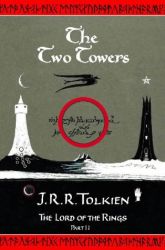Many people who read The Lord of the Rings falter somewhere in The Two Towers, and that’s perfectly understandable. According to J.R.R. Tolkien’s Foreword to the Second Edition of LOTR, he actually faltered in the writing of it, putting the book down for two years before picking up again in book 4. (“Foresight had failed and I had no time for thought,” says J.R.R.)
 It’s a difficult book. Frodo and Sam, the characters we’re most invested in, disappear for a couple hundred pages; Gandalf is presumably dead in the book’s opening chapters; Boromir’s definitely dead; and Aragorn is still something of a distant figure. Gimli is interesting enough but hardly crucial to the plot, and it’s difficult to give two figs about Legolas.
It’s a difficult book. Frodo and Sam, the characters we’re most invested in, disappear for a couple hundred pages; Gandalf is presumably dead in the book’s opening chapters; Boromir’s definitely dead; and Aragorn is still something of a distant figure. Gimli is interesting enough but hardly crucial to the plot, and it’s difficult to give two figs about Legolas.
Then we have the problem of the Rohirrim. As far as I’m concerned, Tolkien doesn’t do a very good job getting the audience to buy in to the kingdom of Rohan. I was shocked to discover that Éowyn is given less than a page in Two Towers, barely enough time for her to show up and cast eyes lovingly at Aragorn. Erkenbrand, Háma, and Gamling are just tertiary characters, nobody we particularly care about. The only person who really grabs your attention in these opening chapters about the Riddermark is Éomer. Before we’ve formed any emotional attachment to Rohan, Théoden’s off to Helm’s Deep.
As for Théoden? Théoden becomes more likable as the book goes on, and he really comes into his own when he rejects Saruman’s offer of peace at Orthanc. But when we first see him, the king of Rohan is just a cranky old man under the sway of bad counsel. Then Gandalf shows up, speaks a few strong words, casts Wormtongue down on his belly — and Théoden has a baffling change of heart. In my LOTR omnibus edition, we first meet Théoden on page 501; Gandalf casts Wormtongue down on page 503; on page 507, the king’s already mustering the troops. Too quick.
Now Gandalf is supposed to be a Maiar of old, and it’s said somewhere that his “magic” is to inspire the people of Middle Earth. To restore them to their youth and vigor, to rekindle the divine spark within. So that could certainly explain Théoden’s sudden shift. But then why didn’t Gandalf accomplish the same thing the last time he saw the king? Okay, there’s a convenient excuse — Gandalf was in a big hurry. But Gandalf’s obviously been in and out of this place many times, and Saruman’s poisoning took years.
So Théoden’s conversion is somewhat puzzling and the Rohirrim are still strangers. Therefore I wasn’t particularly invested in the battle of Helm’s Deep. The battle itself is the first extended battle sequence Tolkien had written since the Battle of Five Armies in The Hobbit, and it’s considerably better done than that. But Peter Jackson’s instincts were correct in trying to build up this battle with every scrap of back story he could find. I struggled hard to care about anyone here but Aragorn, Legolas, and Gimli.
But I want to come back to Théoden’s choice to cast aside Gríma Wormtongue and follow the advice of Gandalf, because such choices are what this book is made of. Everyone gets their moment of choice in Two Towers.
Sam and Frodo stand on the brink of Mordor and decide to press on, even if nobody is left alive to know about it. Saruman is given a clear choice by Gandalf to come down from Orthanc and walk the long, hard road towards forgiveness, or to rot in his tower. Treebeard and the ents must decide whether to confront Saruman or to sit back and await “the withering of all woods.” Even Gollum has a moment standing over the sleeping bodies of Sam and Frodo on the stairs of Cirith Ungol where he briefly reconsiders his evil plot to lead the hobbits to Shelob.
So what are our characters choosing between? For Tolkien, the choice is not complex: there’s light, and then there’s darkness.